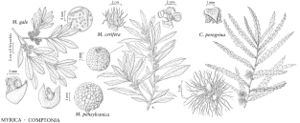Myrica
Sp. Pl. 2: 1024. 175.
Gen. Pl. ed. 5, 449. 1754.
| Taxon | Illustrator ⠉ | |
|---|---|---|
 | Myrica cerifera Comptonia peregrina Myrica gale Myrica pensylvanica | John Myers John Myers John Myers John Myers |
Shrubs or small trees, often aromatic and resinous. Branches spreading, terete, glabrous or pubescent, often gland-dotted. Leaves persistent or deciduous; stipules absent. Leaf-blade aromatic when crushed (except M. inodora), oblanceolate, elliptic, obovate, or oblong-ovate, membranous or leathery, margins entire or serrate-denticulate, especially in distal 1/2, pubescent or glabrous, usually gland-dotted. Inflorescences ± erect, ellipsoid to short-cylindric or ovoid, appearing before or with leaves; bracts ovate, glabrous or variously pubescent. Flowers unisexual, rarely bisexual, staminate and pistillate flowers usually on different plants, infrequently on same plants. Staminate flowers: stamens (2-) 3-12 (-22), shorter or longer than subtending bract; filaments mostly distinct, often connate into branching staminal column, each branch terminated by anther; rudimentary ovary occasionally present. Pistillate flowers: ovary subtended by 2-6 broadly ovate bracteoles, these sometimes persistent and accrescent, always shorter than fruit, sometimes completely absent; styles short. Fruits globose or ovoid to lenticular, smooth or more commonly with warty protuberances, usually covered with waxy coating that dries white. x = 8.
Distribution
Nearly worldwide
Discussion
Species ca. 50 (7 in the flora).
Myrica is often cultivated. Myrica species were used by various tribes of Native Americans for medicinal purposes. Leaves were used for a gynecological aid and an emetic; the bark, as a blood purifier and a kidney aid (D. E. Moerman 1986). Bayberry candles were used by early settlers, and they remain popular household items, both decorative and functional.
Selected References
None.
Lower Taxa
Key
| 1 | Bracts of staminate flowers longer than stamens; bracteoles of pistillate flowers 2, accrescent and adnate to fruit; fruits smooth (without protuberances), lacking waxy deposit (subg. Myrica). | > 2 |
| 1 | Bracts of staminate flowers shorter than stamens; bracteoles of pistillate flowers 4–6, not accrescent or adnate to fruit; fruits with numerous protuberances, usually covered with waxy coating that dries white or blue-white to gray (subg. Morella Loureiro). | > 3 |
| 2 | Bracteoles of pistillate flowers glabrous; leaf margins serrate, usually minutely so, with 1–4 pairs of teeth restricted to distal 1/3 of blade; not extending s of Oregon in w part of range. | Myrica gale |
| 2 | Bracteoles of pistillate flowers densely pilose, especially at apex; leaf margins serrate, often coarsely so, with 4–12 pairs of teeth ± in distal 1/2 of blade; California only. | Myrica hartwegii |
| 3 | Staminate flowers with 6 or more stamens, rarely 2–3, especially in distal flowers; fruit wall, but not warty protuberances, pubescent. | > 4 |
| 3 | Staminate flowers with 3–5(–7) stamens; fruit wall usually glabrous, if pubescent, warty protuberances also pubescent. | > 5 |
| 4 | Margins of leaf blade entire, rarely serrate at apex; blade not aromatic when crushed; flowers unisexual, staminate and pistillate on different plants; restricted to Gulf Coast region. | Myrica inodora |
| 4 | Margins of leaf blade conspicuously serrate almost their entire length; blade fragrant when crushed; flowers bisexual, staminate, and pistillate, all on same plant; Pacific Coast region. | Myrica californica |
| 5 | Leaf blade densely glandular on both surfaces. | Myrica cerifera |
| 5 | Leaf blade densely glandular only abaxially. | > 6 |
| 6 | Fruit wall and warty protuberances densely hirsute when young; branches whitish gray in age; leaves deciduous, membranous; fruits 3.5–5.5 mm. | Myrica pensylvanica |
| 6 | Fruit wall glabrous or sparsely glandular, warty protuberances ± glandular; branches black; leaves persistent or tardily deciduous, leathery; fruits 3–4.5 mm. | Myrica heterophylla |